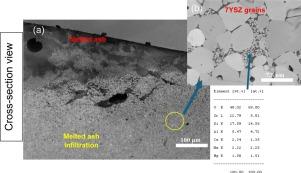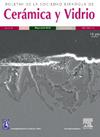Interaction at high temperature of Popocatépetl volcanic ash deposited on yttria-stabilized zirconia sintered coupons
IF 2.7
4区 材料科学
Q1 MATERIALS SCIENCE, CERAMICS
Boletin de la Sociedad Espanola de Ceramica y Vidrio
Pub Date : 2025-05-01
DOI:10.1016/j.bsecv.2025.01.002
引用次数: 0
Abstract
This work aims to study the interaction of sintered yttria-stabilized zirconia (7YSZ) ceramic under a volcanic ash mix at an engine representative temperature of 1350 °C. In this work, two different locations – distance from Mexico Popocatépetl Volcano were chosen to collect the ashes, and to perform their melting process with variable chemical composition. Afterward, each ash was deposited on the surface of 7YSZ ceramic coupons, then they were exposed at heating and cooling cycles at designed temperature equal to 1350 °C. After 8 cycles of thermal treatment testing of 8 h, the morphology and microstructure analysis of the 7YSZ coupons was carried out using microscopy and X-ray diffraction analysis techniques. The results showed that a molten ash layer, with smooth morphology of size of 60 μm of thick, was formed on the ceramic surface. Based on the observed degradation, the general status of the coupons after 8 cycles of thermal test, presented failure by growth of large cracks which were associated to the infiltration of melted ash through the thickness of ceramic coupon. This melted ash infiltrated trough the fine grain microstructure, promoted the development of a compose rich in silica, which is brittle and therefore promoted cracks initiation with subsequent propagation in the substrate.

popocatacimetel火山灰沉积在氧化钇稳定氧化锆烧结板上的高温相互作用
本研究旨在研究在1350℃的发动机代表温度下,烧结钇稳定氧化锆(7YSZ)陶瓷在火山灰混合物下的相互作用。在这项工作中,选择了两个不同的地点-距离墨西哥popocat petl火山很远的地方收集灰烬,并以不同的化学成分进行它们的融化过程。然后,将各灰分沉积在7YSZ陶瓷片的表面,然后在1350℃的设计温度下进行加热和冷却循环。经过8次8 h的热处理测试后,利用金相显微镜和x射线衍射分析技术对7YSZ试样进行形貌和显微组织分析。结果表明:在陶瓷表面形成了一层厚度为60 μm的光滑的熔灰层;从观察到的退化情况来看,经过8个循环热试验后,瓷片的总体状态表现为出现较大裂纹,这与熔融灰渗透陶瓷瓷片厚度有关。熔融灰通过细晶组织渗透,促进了富含二氧化硅的组分的发展,这种组分很脆,因此促进了裂纹的萌生和随后在基体中的扩展。
本文章由计算机程序翻译,如有差异,请以英文原文为准。
求助全文
约1分钟内获得全文
求助全文
来源期刊

Boletin de la Sociedad Espanola de Ceramica y Vidrio
工程技术-材料科学:硅酸盐
CiteScore
5.50
自引率
2.90%
发文量
72
审稿时长
103 days
期刊介绍:
The Journal of the Spanish Ceramic and Glass Society publishes scientific articles and communications describing original research and reviews relating to ceramic materials and glasses. The main interests are on novel generic science and technology establishing the relationships between synthesis, processing microstructure and properties of materials. Papers may deal with ceramics and glasses included in any of the conventional categories: structural, functional, traditional, composites and cultural heritage. The main objective of the Journal of the Spanish Ceramic and Glass Society is to sustain a high standard research quality by means of appropriate reviewing procedures.
 求助内容:
求助内容: 应助结果提醒方式:
应助结果提醒方式:


